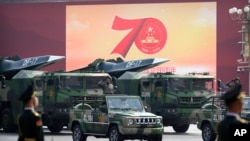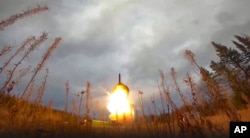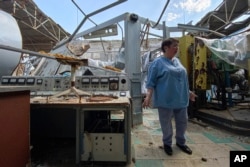Ahead of the U.S.-China nuclear arms control talks in Washington, D.C. on November 6, a pro-government political influencer Hu Xijin pushed the idea that nuclear non-proliferation does not concern China as Beijing is not a party to the nuclear arms race.
Writing on Weibo, a Chinese social media platform where he has close to 25 million followers, Hu, former editor-in-chief of the state-backed newspaper Global Times, admitted that the U.S. and China “need to strengthen communication around this critical issue to prevent serious miscalculation.”
Yet, he argued that the United States is attempting to limit Beijing’s nuclear deterrent capabilities by dragging China into “U.S.-Russia nuclear arms control negotiations.”
China “reserves the right to build a strong nuclear arsenal,” and the talks in Washington do not signal a start of formal negotiations to set limits to the sides’ nuclear arsenals, he said.
Hu wrote: “… nuclear arms control is a special responsibility of the U.S. and Russia.”
This is misleading.
The Pentagon says Beijing is developing nuclear warheads on an unprecedented scale.
China has accumulated more than 500 nuclear warheads and is on track to have 1,500 of them by 2035, the Pentagon’s October 19 report said.
“Compared to the PLA's [People’s Liberation Army] nuclear modernization efforts a decade ago, current efforts dwarf previous attempts in both scale and complexity," the report said.
The Stockholm International Peace Research Institute’s (SIPRI) China assessment for 2023 concurred with the U.S. defense department’s findings. It pointed out that China’s rapid expansion of its nuclear program signals a shift in Beijing’s “minimum deterrent” doctrine. SIPRI said China has been simultaneously advancing a nuclear triad comprising of land-based, sea-based, and air-based nuclear delivery systems.
Currently, Russia and the U.S. together possess almost 90% of all nuclear weapons globally. According to the Arms Control Association, a D.C.-based watchdog, Russia has 4,500 warheads, while the U.S. has about 3,700.
However, the now-suspended New Start Treaty limits both Washington’s and Moscow’s deployment of warheads (ready to be launched at any time) to 1,550 each.
The U.S. Department of Defense’s latest projection puts China on par with both Russia and the U.S. with about 1,500 nuclear warheads already in its arsenal by 2035.
The New York Times warned in a November 4 editorial, that China’s accelerated nuclear weapons program could potentially cause another spike in global nuclear proliferation as “the United States and Russia may each feel that they then need to expand their own arsenals to match the combined total of the other two powers.”
The Russian state corporation Rosatom has been providing highly enriched uranium for Chinese fast breeder reactors, John R. Plumb, assistant secretary of defense, told the U.S. Congress on March 8.
“[T]here's no getting around the fact that breeder reactors are plutonium, and plutonium is for weapons, And, of course, it matches our concerns about China's increased expansion of its nuclear forces as well, because you need more plutonium for more weapons,” Plumb said.
Two weeks later, on March 22, Rosatom confirmed signing a “long-term cooperation program in the area of fast reactors and nuclear fuel cycle closure” with the Atomic Energy Agency of China, Beijing’s nuclear industry watchdog.
The New York Times reported in April that the deal showcased a project that would aid Beijing’s and Moscow’s nuclear modernizations, and “produce arsenals whose combined size could dwarf that of the United States.”
“The United States is now facing questions about how to manage a three-way nuclear rivalry, which upends much of the deterrence strategy that has successfully avoided nuclear war,” The NYT reported.
China insists the breeder reactors will be purely used for civilian purposes.
During President Barack Obama’s administration, the United States attempted to move the world beyond nuclear weapons. However, Russia’s systematic nuclear saber-rattling and its war on Ukraine have reversed the non-proliferation efforts.
In February 2022, Russia placed its nuclear force on high alert. In September 2022, Russian President Vladimir Putin warned the West to take his nuclear threats seriously.
Shortly before Moscow launched its war on Kyiv, Putin and Chinese President Xi Jinping announced that their countries will engage in a strategic relationship with “no limits” as they share the desire to curb the United States’ power and challenge its “hegemony.”


